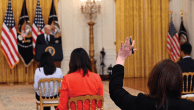
Immigration was a top focus of early Biden coverage, especially among outlets with right-leaning audiences
Immigration was one of the five topics most covered by 25 major news outlets in the first 60 days of the Biden administration.
Numbers, Facts and Trends Shaping Your World
All
Publications
About two-thirds of news coverage dealt with Biden’s policy agenda, while about three-quarters of early Trump coverage was framed around leadership skills.
